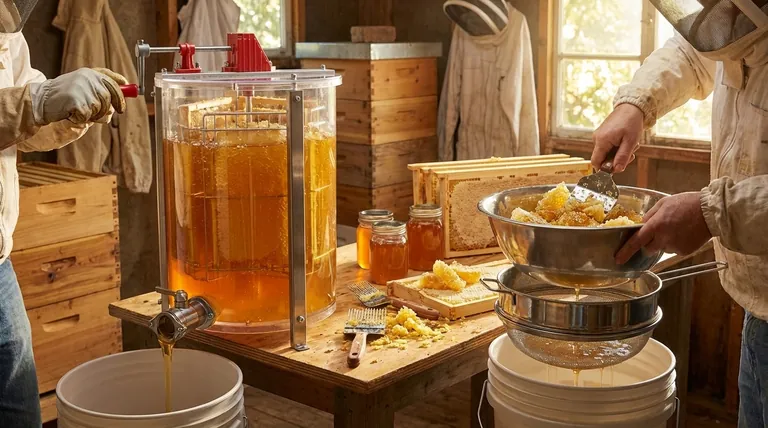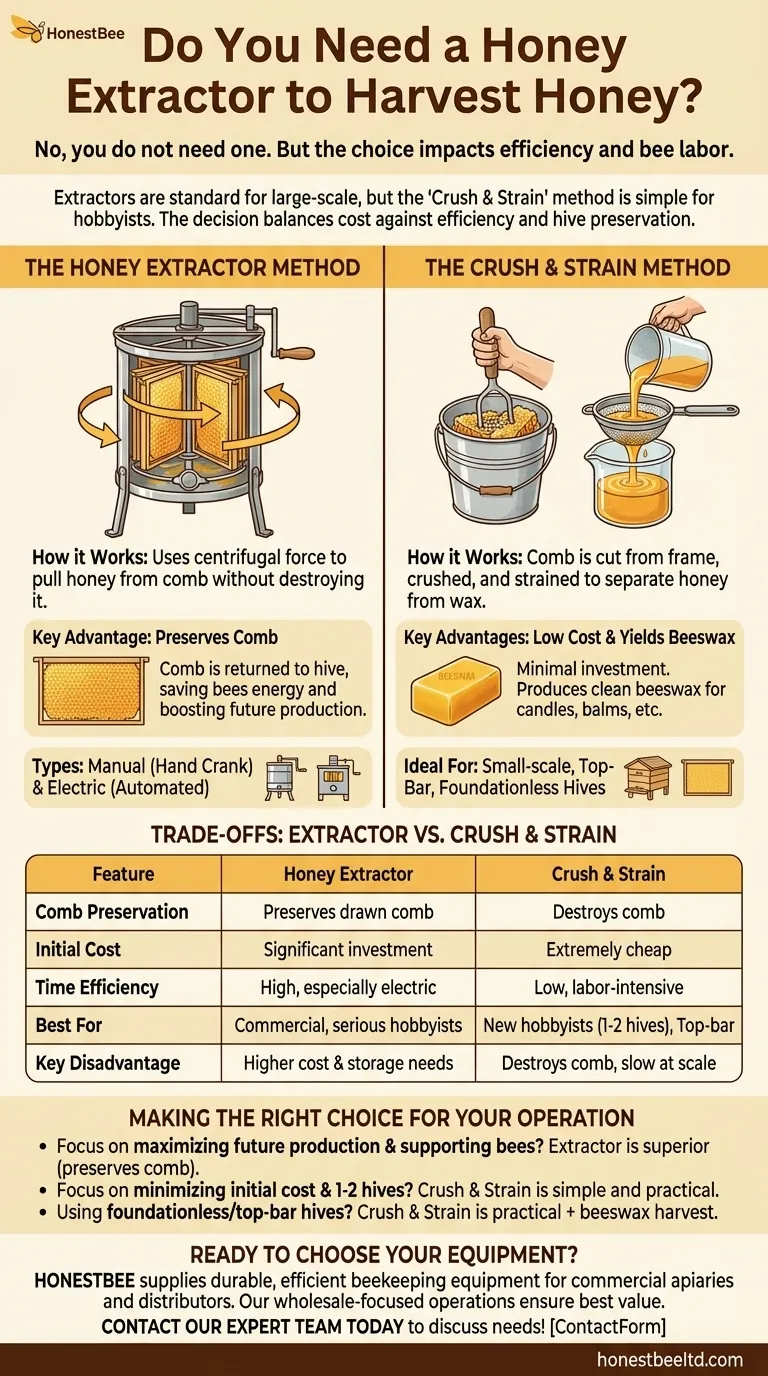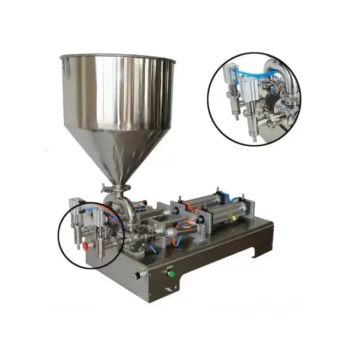No, you do not need a honey extractor to harvest honey. While extractors are the standard tool for efficient, large-scale honey collection, a simple and effective alternative known as the "crush and strain" method allows any beekeeper to harvest honey with minimal equipment. This method is particularly well-suited for new hobbyists or those with only a few hives.
The decision to use an extractor is not about whether you can harvest honey without one, but about balancing efficiency and scale against cost and the preservation of your bees' hard work. Your choice directly impacts both your workflow and your colony's resources for the next season.

How a Honey Extractor Works
A honey extractor is a machine that uses centrifugal force to pull honey from the comb without destroying it. This preservation of the comb is its single most important benefit.
The Extraction Process
The process is straightforward. First, you use a heated knife or fork to slice off the thin beeswax caps that seal the honey-filled cells. The frames are then placed into baskets inside the extractor's drum. As you turn a crank (manual) or flip a switch (electric), the frames spin rapidly, slinging the honey out against the inner wall of the drum where it drips down to a collection gate.
The Value of Preserving Comb
After extraction, the "wet" frames—now empty of honey but still coated in a thin layer—can be returned to the hive. Bees expend an enormous amount of energy and resources to build beeswax comb. By returning the intact comb, you give the colony a massive head start on storing the next batch of honey, significantly boosting their productivity.
Types of Extractors
Extractors come in two main varieties: manual and electric. Manual extractors are operated by a hand crank and are a cost-effective choice for hobbyists with a few hives. Electric models automate the spinning, processing a large number of frames quickly and making them essential for commercial or serious sideline operations. In either case, durable stainless steel models are recommended for longevity and ease of cleaning.
The Alternative: The Crush and Strain Method
The crush and strain method is the original, low-tech way to harvest honey. It is simple, requires very little investment, and is an excellent way to start.
The Crush and Strain Process
This method involves cutting the entire honeycomb away from the frame. The comb is then placed in a food-grade bucket or container and crushed with a masher or your hands. This action breaks open all the wax cells, releasing the honey. The resulting mixture of honey and wax is then poured through a series of strainers or cheesecloth to separate the liquid honey from the solid wax particles.
When to Use This Method
Crush and strain is ideal for beekeepers with only one or two hives, as the investment in an extractor may not be justified. It is also the primary method for harvesting from top-bar hives or from foundationless frames, where the natural comb lacks the reinforcement needed to withstand the forces of an extractor.
A Valuable Byproduct: Beeswax
A major advantage of this method is the harvest of beeswax. While an extractor preserves the comb in the frame, crush and strain separates it completely. This block of clean beeswax is a valuable commodity that can be used for making candles, balms, and other products.
Understanding the Trade-offs: Extractor vs. Crush and Strain
Choosing your harvesting method involves a clear set of trade-offs. There is no single "best" answer; the right choice depends entirely on your goals and the scale of your operation.
Key Difference: Comb Destruction
An extractor's primary function is to preserve the drawn-out comb. This saves the bees immense energy. The crush and strain method destroys the comb, forcing the bees to rebuild it from scratch, which consumes resources that could have otherwise been used for making more honey.
Initial Cost and Equipment
The crush and strain method is extremely cheap, requiring little more than a bucket, a strainer, and a knife. A honey extractor represents a significant financial investment, with even small manual models costing several hundred dollars, and they require dedicated storage space.
Time and Labor Efficiency
For just a handful of frames, crush and strain can be quick and satisfying. However, as the number of frames increases, it becomes a slow, messy, and labor-intensive process. An extractor provides unparalleled efficiency, allowing a beekeeper to process dozens of frames in the time it would take to crush and strain a few.
Making the Right Choice for Your Operation
To select the best method, evaluate your beekeeping goals, budget, and hive type. Your decision should be a deliberate one that aligns with your specific context.
- If your primary focus is maximizing future honey production and supporting your bees: An extractor is the superior choice because preserving the comb gives your colony a critical head start.
- If your primary focus is minimizing initial cost and you have only 1-2 hives: The crush and strain method is a simple, practical, and highly effective way to harvest your honey.
- If you are using foundationless frames or top-bar hives: The crush and strain method is your most practical option and provides the added benefit of a valuable beeswax harvest.
Ultimately, the best harvesting method is the one that fits the scale of your passion and respects the incredible labor of your bees.
Summary Table:
| Method | Best For | Key Advantage | Key Disadvantage |
|---|---|---|---|
| Honey Extractor | Commercial apiaries, serious hobbyists | Preserves honeycomb for bee efficiency | Higher initial cost and storage needs |
| Crush & Strain | New hobbyists, 1-2 hives, top-bar hives | Low cost, yields harvestable beeswax | Destroys comb, labor-intensive at scale |
Ready to choose the right equipment for your honey harvest?
Whether you're a commercial apiary scaling up operations or a distributor stocking reliable gear, HONESTBEE supplies the durable, efficient beekeeping equipment you need to succeed. Our wholesale-focused operations ensure you get the best value on honey extractors and essential supplies.
Contact our expert team today to discuss your specific needs and streamline your harvest!
Visual Guide

Related Products
- HONESTBEE 3-Frame Manual Acrylic Honey Extractor
- electric honey extractor honey centrifuge 3 frame honey extractor stainless steel honey frame extractor
- Electric 8 Frame Honey Spinner Extractor Equipment for Beekeeping
- Commercial Electric 12 Frame Honey Extractor Spinner Motorized Honey Extractor
- 8-Frame Electric Self-Reversing Honey Extractor Spinner for Commercial Honey Extraction Equipment
People Also Ask
- What machines are needed in beekeeping besides basic tools? Scale Your Honey Harvest Efficiently
- What is the most common method for cleaning a honey extractor? Protect Your Honey & Equipment
- How do you collect honey at home? A Beginner's Guide to Harvesting from Your Hive
- How do you manually extract honey? Choose the Best Method for Your Hive
- Which type of honey extractor is generally more durable? Focus on Material & Build Quality for Longevity



















